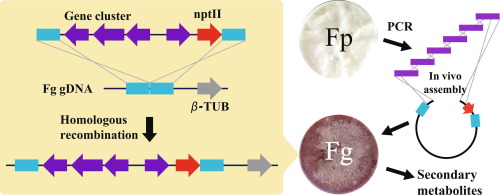当前位置:
X-MOL 学术
›
Fungal Genet. Biol.
›
论文详情
Our official English website, www.x-mol.net, welcomes your feedback! (Note: you will need to create a separate account there.)
Heterologous expression of intact biosynthetic gene clusters in Fusarium graminearum.
Fungal Genetics and Biology ( IF 3 ) Pub Date : 2019-07-04 , DOI: 10.1016/j.fgb.2019.103248 Mikkel Rank Nielsen 1 , Rasmus Dam Wollenberg 2 , Klaus Ringsborg Westphal 2 , Teis Esben Sondergaard 2 , Reinhard Wimmer 2 , Donald Max Gardiner 3 , Jens Laurids Sørensen 1
Fungal Genetics and Biology ( IF 3 ) Pub Date : 2019-07-04 , DOI: 10.1016/j.fgb.2019.103248 Mikkel Rank Nielsen 1 , Rasmus Dam Wollenberg 2 , Klaus Ringsborg Westphal 2 , Teis Esben Sondergaard 2 , Reinhard Wimmer 2 , Donald Max Gardiner 3 , Jens Laurids Sørensen 1
Affiliation

|
Filamentous fungi such as species from the genus Fusarium are capable of producing a wide palette of interesting metabolites relevant to health, agriculture and biotechnology. Secondary metabolites are formed from large synthase/synthetase enzymes often encoded in gene clusters containing additional enzymes cooperating in the metabolite's biosynthesis. The true potential of fungal metabolomes remain untapped as the majority of secondary metabolite gene clusters are silent under standard laboratory growth conditions. One way to achieve expression of biosynthetic pathways is to clone the responsible genes and express them in a well-suited heterologous host, which poses a challenge since Fusarium polyketide synthase and non-ribosomal peptide synthetase gene clusters can be large (e.g. as large as 80 kb) and comprise several genes necessary for product formation. The major challenge associated with heterologous expression of fungal biosynthesis pathways is thus handling and cloning large DNA sequences. In this paper we present the successful workflow for cloning, reconstruction and heterologous production of two previously characterized Fusarium pseudograminearum natural product pathways in Fusarium graminearum. In vivo yeast recombination enabled rapid assembly of the W493 (NRPS32-PKS40) and the Fusarium Cytokinin gene clusters. F. graminearum transformants were obtained through protoplast-mediated and Agrobacterium tumefaciens-mediated transformation. Whole genome sequencing revealed isolation of transformants carrying intact copies the gene clusters was possible. Known Fusarium cytokinin metabolites; fusatin, 8-oxo-fusatin, 8-oxo-isopentenyladenine, fusatinic acid together with cis- and trans-zeatin were detected by liquid chromatography and mass spectrometry, which confirmed gene functionality in F. graminearum. In addition the non-ribosomal lipopeptide products W493 A and B was heterologously produced in similar amounts to that observed in the F. pseudograminearum doner. The Fusarium pan-genome comprises more than 60 uncharacterized putative secondary metabolite gene clusters. We nominate the well-characterized F. graminearum as a heterologous expression platform for Fusarium secondary metabolite gene clusters, and present our experience cloning and introducing gene clusters into this species. We expect the presented methods will inspire future endevours in heterologous production of Fusarium metabolites and potentially aid the production and characterization of novel natural products.
中文翻译:

完整的禾本科镰刀菌生物合成基因簇的异源表达。
丝状真菌(例如镰刀菌属的物种)能够产生与健康,农业和生物技术有关的各种有趣的代谢产物。次生代谢物是由通常在基因簇中编码的大型合酶/合成酶形成的,这些基因簇包含在代谢物的生物合成中协同作用的其他酶。真菌代谢组的真正潜力尚未开发,因为大多数次级代谢产物基因簇在标准实验室生长条件下是沉默的。实现生物合成途径表达的一种方法是克隆负责的基因,并在合适的异源宿主中表达它们,这是一个挑战,因为镰孢镰刀菌聚酮化合物合酶和非核糖体肽合成酶基因簇可能很大(例如 (最大80 kb),并包含几个产物形成所必需的基因。因此,与真菌生物合成途径的异源表达相关的主要挑战是处理和克隆大的DNA序列。在本文中,我们介绍了在禾谷镰刀菌中两个先前表征的假镰刀菌天然产物途径的成功克隆,重建和异源生产的成功工作流程。体内酵母重组使W493(NRPS32-PKS40)和镰刀菌细胞分裂素基因簇的快速组装成为可能。通过原生质体介导和根癌农杆菌介导的转化获得禾谷镰刀菌转化体。全基因组测序揭示了携带完整拷贝的基因簇的转化子的分离是可能的。已知镰刀菌细胞分裂素代谢物;fusatin,8-氧代-fusatin,通过液相色谱和质谱法检测了8-氧代异戊烯基腺嘌呤,夫斯汀酸以及顺式和反式玉米素,证实了禾谷镰刀菌中的基因功能。另外,非核糖体脂肽产物W493A和B是异源产生的,其数量与伪造假单胞菌中观察到的数量相似。镰刀菌全基因组包含60多个未表征的假定次级代谢产物基因簇。我们提名特征明确的禾谷镰刀菌作为镰刀菌次生代谢物基因簇的异源表达平台,并介绍我们的克隆和将基因簇引入该物种的经验。
更新日期:2019-07-04
中文翻译:

完整的禾本科镰刀菌生物合成基因簇的异源表达。
丝状真菌(例如镰刀菌属的物种)能够产生与健康,农业和生物技术有关的各种有趣的代谢产物。次生代谢物是由通常在基因簇中编码的大型合酶/合成酶形成的,这些基因簇包含在代谢物的生物合成中协同作用的其他酶。真菌代谢组的真正潜力尚未开发,因为大多数次级代谢产物基因簇在标准实验室生长条件下是沉默的。实现生物合成途径表达的一种方法是克隆负责的基因,并在合适的异源宿主中表达它们,这是一个挑战,因为镰孢镰刀菌聚酮化合物合酶和非核糖体肽合成酶基因簇可能很大(例如 (最大80 kb),并包含几个产物形成所必需的基因。因此,与真菌生物合成途径的异源表达相关的主要挑战是处理和克隆大的DNA序列。在本文中,我们介绍了在禾谷镰刀菌中两个先前表征的假镰刀菌天然产物途径的成功克隆,重建和异源生产的成功工作流程。体内酵母重组使W493(NRPS32-PKS40)和镰刀菌细胞分裂素基因簇的快速组装成为可能。通过原生质体介导和根癌农杆菌介导的转化获得禾谷镰刀菌转化体。全基因组测序揭示了携带完整拷贝的基因簇的转化子的分离是可能的。已知镰刀菌细胞分裂素代谢物;fusatin,8-氧代-fusatin,通过液相色谱和质谱法检测了8-氧代异戊烯基腺嘌呤,夫斯汀酸以及顺式和反式玉米素,证实了禾谷镰刀菌中的基因功能。另外,非核糖体脂肽产物W493A和B是异源产生的,其数量与伪造假单胞菌中观察到的数量相似。镰刀菌全基因组包含60多个未表征的假定次级代谢产物基因簇。我们提名特征明确的禾谷镰刀菌作为镰刀菌次生代谢物基因簇的异源表达平台,并介绍我们的克隆和将基因簇引入该物种的经验。



























 京公网安备 11010802027423号
京公网安备 11010802027423号